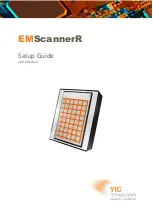
Lake Shore Model 370 AC Resistance Bridge User’s Manual
•
Short, 12” (30cm), Calibration Cable to connect voltage and current leads of the Model 370 to resistive loads or a
short.
•
Short, 12” (30cm), Calibration Cable to connect voltage and current leads of the Model 3716 Scanner to resistive
loads.
•
Test leads for the multimeter to connect across the instrument voltage leads.
•
Resistive Loads of the following nominal values, known to 0.01% accuracy:
Nominal Actual Nominal Actual
2
Ω
6
Ω
20
Ω
60
Ω
200
Ω
600
Ω
2 k
Ω
6 k
Ω
20 k
Ω
60 k
Ω
200 k
Ω
600 k
Ω
2 M
Ω
NOTE:
Resistor values of 1,3 multiples can be substituted for the above recommended 2,6 multiples but more
averaging may be required to achieve the same results. Four terminal connections are necessary for lower
value resistors.
To calibrate both voltage and current perform the following sequence of operations. The resulting calibration accuracy
from this procedure depends only on the accuracy of the calibration resistors being used and not the DMM. The order of
operations was chosen to keep known resistance values between 2
Ω
and 2 M
Ω
, make calibrations at the most stable
operating point available for the current range or voltage setting and minimize the number of times a calibrated range is
used to calibrate another range. Refer to the work sheet below for range dependant information.
1. Allow the Model 370 to warm up to 1 hour. Disconnect the scanner if present and attach a resistive load during
warm up. Select the default frequency of 13.7 Hz.
2. Calibrate all voltage zero offsets: Follow the procedure described in 8.12.2.1. Be sure to set all voltage gain
coefficients to default (1).
3. Calibrate the 632 mV voltage gain (only): Follow the procedure described in 8.12.2.2. (Small measurement errors in
this step will not contribute to the final resistance measurement accuracy.)
4. Calibrate current gains from 31.6 mA through 1
μ
A: Remain on the 632 mV range that now has both voltage
coefficients. Follow the procedure described in 8.12.2.3 and repeat down through the 1
μ
A setting.
5. Calibrate all remaining voltage gains from 200 mV to 2
μ
V: Remain on the 1
μ
A current setting which is now
calibrated.
•
Attach a near full-scale resistor of known value to the input of the instrument.
•
Read and record the RDGR? resistance value.
•
Calculate the voltage gain coefficient: CALG = Actual Resistance/RDGR.
•
Send the coefficient to the instrument.
•
Repeat for all voltage ranges from 200 mV to 2
μ
V.
6. Calibrate current gains from 316 nA to 10 pA: Remain on the 200 k
Ω
resistance range. Follow procedure described
in 8.12.2.3 except use the 200 k
Ω
resistance range instead of the “highest resistance range available”.
7. Calibrate the last two current gains of 3.16 pA and 1 pA: Remain on 2
μ
V range and use 600 k
Ω
and 2 M
Ω
resistors
for their respective ranges. Follow procedure described in Paragraph 8.12.2.3.
8. Calibrate frequency compensation as described in Paragraph 8.12.2.4.
9. Calibrate scanner compensation as described in Paragraph 8.12.2.5.
10. Send the CALSAVE command and wait 10 seconds for the calibration to be saved in non-volatile memory.
(Alternatively this step can be done after all ranges are calibrated.)
8-20
Service
Содержание 370
Страница 22: ...Lake Shore Model 370 AC Resistance Bridge User s Manual 1 12 Introduction This Page Intentionally Left Blank ...
Страница 60: ...Lake Shore Model 370 AC Resistance Bridge User s Manual 3 16 Installation This Page Intentionally Left Blank ...
Страница 106: ...Lake Shore Model 370 AC Resistance Bridge User s Manual 5 12 Advanced Operation This Page Intentionally Left Blank ...
















































